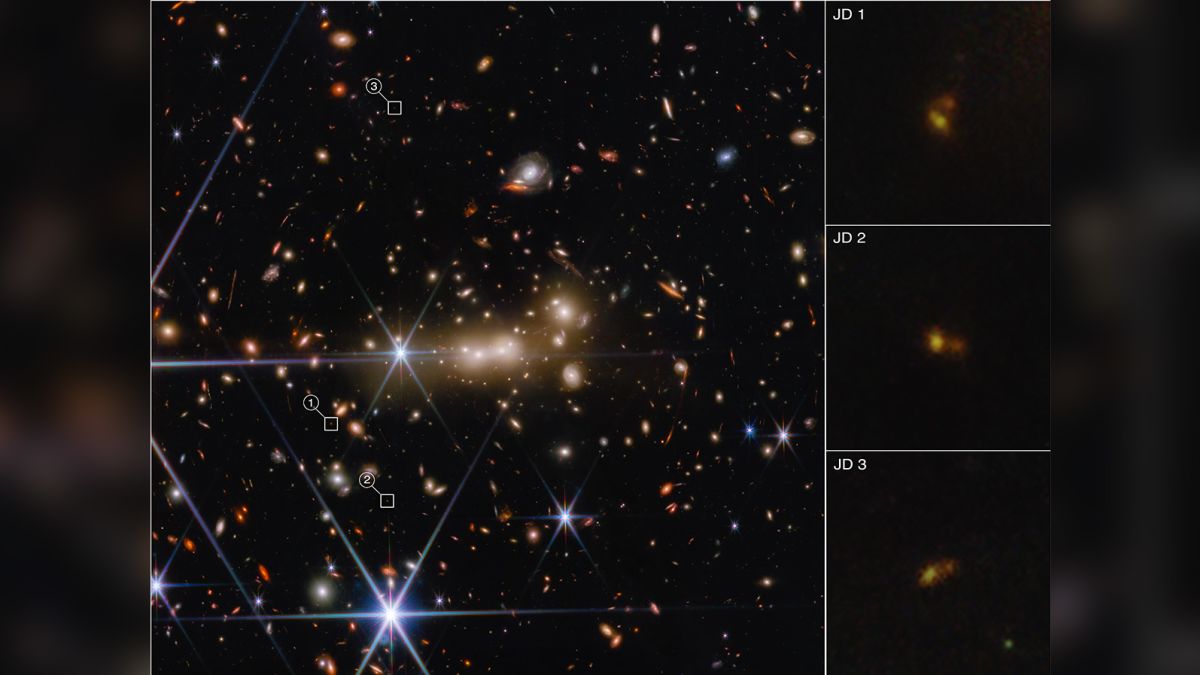(CNN) — The James Webb Space Telescope has given astronomers a glimpse of the universe’s earliest moments in a new image shared Wednesday.
The powerful space observatory is capable of detecting the faint glow of incredibly distant galaxies as they shine in infrared light, a wavelength invisible to the human eye. The Web is an important tool that astronomers can use to better understand how galaxies formed and evolved in the early universe.
The telescope captured an image of the constellation MACS0647 and the distant galaxy MACS0647-JD. The cluster appears as a dazzling group of galaxies that seem to sparkle like precious gems against the dark background of space.
Galaxy cluster MACS0647 bends and increases the brightness of the more distant galaxy MACS0647-JD. Credit: NASA
Visible due to a type of observational phenomenon caused by a very distant galaxy cluster. This phenomenon, called gravitational lensing, occurs when foreground galaxies act like a magnifying glass for distant objects behind them.
Small boxes were used to locate the galaxy MACS0647-JD, and detailed images are aligned on the right side of the image. The cluster essentially makes three lenses of the galaxy, magnifying it and making it appear in three different places in the image. Each box on the right shows a different detail of the galaxy.
Astronomer Don Ko discovered the galaxy MACS0647-JD 10 years ago with the Hubble Space Telescope. Webb’s new image of the Galaxy revealed a surprise: it has two distinct features.
“Through Hubble, it was a pale red dot. We could tell it was very small, a small galaxy in the first 400 million years of the universe,” said Koh, an astronomer at the space agency’s Space Telescope Science Institute. Union and Association of Universities for Astronomical Research, Ill liberation From NASA.
“Now we look at the web and can distinguish two objects! We are seriously debating whether it is two galaxies or two groups of stars in one galaxy. We don’t know, but these are the questions that were in the web. Designed”.
The two objects differ in color, one being more blue and the other red. Colors represent different gases. Blue material indicates young star formation, while red material is dusty and old. Astronomers believe that the two objects in the galaxy image may suggest a connection between the two galaxies.
Tiger Yu-Yang Seo, a doctoral student at Johns Hopkins University, said in a statement that “it is very interesting to see two structures in such a small system.” “We’re witnessing a galactic merger in the early universe. If it’s a very distant merger, I’ll be really ecstatic!”
The research team wrote A Article about finding a possible link, but, like Webb’s first observations since beginning scientific operations in July, the findings have yet to go through the peer-review process. The team also plans a detailed study of MACS0647-JD in January.
Each web observation reveals hitherto hidden and unseen aspects of the universe, as the telescope has the ability to see faint infrared light through thick interstellar dust. Astronomers are excited about the telescope’s potential for discoveries, as the observatory began its estimated 20-year mission just a few months ago.
“Until now, galaxies in the early universe haven’t really been studied in detail. Before the web we only had dozens,” says Rebecca Larson, a National Science Foundation fellow and doctoral student at the University of Texas. In Austin, it’s a statement. “Studying them will help us understand how they evolved into the galaxy we live in today, and how the universe has evolved over time.”


:quality(85)/cloudfront-us-east-1.images.arcpublishing.com/infobae/SMPW7M5BQFERBOQUPJXKCOKARY.jpg)
:quality(85)/cloudfront-us-east-1.images.arcpublishing.com/infobae/NP5NEZXMZFGNLBHNEQJHPJVMKM.jpg)

:quality(85)/cloudfront-us-east-1.images.arcpublishing.com/infobae/X7DZAL3I4REJTKPZ4Y4DYBHFMI.jpg)